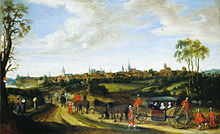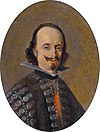Peace of Munster (painting)

|
| Der Friede von Münster (The swearing of the oath of ratification of the treaty of Münster in 1648) |
|---|
| Gerard ter Borch , 1648 |
| Oil on copper |
| 45, 4 x 58.7 cm |
| Rijksmuseum Amsterdam |
The Peace of Münster is a painting by Gerard ter Borch . The image is listed in catalogs as the evocation of the Peace of Westphalia (The swearing of the oath of ratification of the treaty of Münster in 1648), the Treaty of Münster or the Peace of Westphalia in Münster .
Historical background
The historical picture records the moment when a separate peace treaty was sworn in , which was concluded between Spain and the Netherlands in 1648 as part of the peace negotiations in Münster . After four years of tough negotiations, the 80-year revolt of the Dutch against Spanish supremacy was peacefully ended. Negotiating goal of the Dutch was their national independence from Spain. The central aim of the Spanish crown was to separate the northern Netherlands from the French alliance system. With the conclusion of the contract, Spain recognized the full sovereignty of the northern Netherlands and renounced the seven provinces , including the Scheldt estuary . Spain accepted Calvinism in the seven provinces, lifted the restrictions on Dutch merchant drivers in the East and West Indies and agreed to regulate shipping in the Scheldt estuary through tariffs.
In 1645 Ter Borch was invited by the Dutch ambassador and later negotiator, the diplomat and later pensioner Adriaan Pauw , to accompany him to Munster. Ter Borch painted a picture of Pauw's entry into the city as well as several small-format portraits of the diplomats involved in the negotiations, including Don Gaspar de Bracamanonte and Conde de Peneranda , who took Ter Borch into his service as court painter and subsequently commissioned him Spain mediated. Ter Borch was given the opportunity to witness the peace treaty between Holland and Spain on May 15, 1648.
description
The picture shows the moment of the solemn swearing-in of the treaty. The state ceremony takes place in the town hall of Münster. The many participants, who are all portrayed with portrait accuracy, line up next to each other across the entire width of the hall behind the table, whereby Ter Borch avoids monotony in the composition by a slightly asymmetrical grouping of the respective foreground and alternating background figures.
The six negotiators from the Dutch on the one hand - they are Willem Ripperda , Frans van Donia, Adriaan Clant tot Stedum, Adriaan Pauw , Jan van Mathenesse and Barthold van Gent - and the three Spanish representatives on the other, have sat around a round table gathered and are about to swear the contract, the Dutch with their hands raised, while the Spaniards have laid their rights on an open Bible with a metal cross. The table is covered by a heavy green velvet cloth with a gold border, it reaches down to the floor. On the table next to the Bible are the sealed contracts and a precious metal-clad cassette.
The room is shown in great detail with its dark wooden wall paneling from the 16th century, the carvings on the armrests of the municipal benches and the lush decoration with evergreen bushes in the two corners of the room. Bright daylight falls from the right through the tall windows onto the assembly, revealing every single face. A representative of the city guard with gauntlet boots and a plumed hat, who leans on the back of the judge's chair, as well as a man in a wide red coat and blue stockings and the Franciscan from the entourage of the Spaniards on the other side of the picture add color accents.
The image is given the status of a historical document through realistic and recognizable details, with which the space and time of the signing of the contract are recorded. Through his own presence in the picture - he stands on the far left, is dressed in gray, has shoulder-length blond hair and looks at the viewer - ter Borch documents his eyewitnesses.
A golden chandelier with a crowned Madonna in a halo , the baby Jesus in her arms, hovers over the assembly . Ter Borch has emphasized the importance of Our Lady by enlarging the figure. That her blessing may also rest on the Peace of Munster is emblematically emphasized here .
Provenance
The picture that the painter obviously couldn't or didn't want to sell - he had 6000 fl. set as a sales price - was in his estate when Ter Borch died, it came to the pension master Hornbraken († 1780) via inheritance, was sold and often changed hands. From the van Leyen collection in Amsterdam it was sold to Talleyrand in 1804 for 16,000 francs . After further stops, 45,000 fans went to the Russian patron Anatole Demidow , came to England, was owned by Sir Richard Wallace in 1871 , who at that time donated it to the National Gallery in London. In 2000, the museum loaned the painting to the Rijksmuseum in Amsterdam, where it is now on display.
distribution
In 1648 Ter Borch commissioned the Haarlem engraver Jonas Suyderhoef (1613–1689) to make an engraving in the format of the original, which was distributed in large editions. The engraving was not finished until 1650 and contained the addition ICON EXACTISSIMA. QUA AD VIVUM EXPRIMITUR SOLENNIS CONVENTUS […] (“Exact image that represents the high assembly after life […]”) and on the wall the inscription PAX OPTIMA RERUM (“Peace is the best of all things”).
See also
Individual evidence
- ↑ Johann Wussin : Jonas Suyderhoef. Directory of his engravings. Rudolph Weigel, Leipzig 1861, pp. 58–59 ( digitized version ).
- ↑ Kettering 1998.
- ↑ Johann Wussin: Jonas Suyderhoef. Directory of his engravings. Rudolph Weigel, Leipzig 1861, p. 59 ( digitized version ).
Web links
- The Ratification of the Treaty of Münster, National Gallery, London
- The Vrede von Münster as the birth of the Netherlands .
- Christoph Schäfer: The long road to peace.
literature
- Alison M. Kettering: Gerard ter Borch's "Conjuring the Ratification of the Peace of Munster" as a history picture. In: Klaus Bußmann , Heinz Schilling (Ed.): 1648 - War and Peace in Europe. (26th Council of Europe Exhibition). Volume 2: Art and Culture. Bruckmann, Munich 1998, ISBN 3-88789-127-9 , pp. 605-614 ( full text ).


